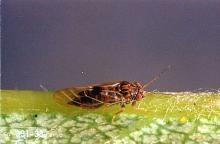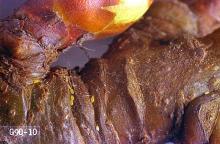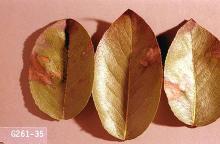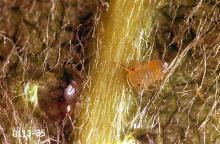Cacopsylla pyricola
Pest description and crop damage Pear psylla is one of the major pear pests in commercial orchards. The adult resembles a miniature cicada. Adults have two distinct forms, a summer and winter form, which differ in appearance. Winterform adults are 0.1 inch in length, dark black and red in appearance, with transparent wings held roof-like over the body. Summerform adults are smaller at 0.08 inch long, light greenish to brown. The nymphs pass through five growth stages, each stage being larger, flatter, and more oval than the last. The first stage is creamy yellow, the last is dark green or brown. All stages have conspicuous red eyes. During the first three stages, the nymphs are encased in a drop of honeydew. Nymphs and adults suck plant juices, producing honeydew that drips onto leaves and fruit. This encourages growth of sooty mold, which causes russeting of the fruit. Blackening and burning of leaf tissue also is typical of psylla infestations. Large numbers of psylla can stunt and defoliate trees and cause fruit-drop.
Biology and life history Pear psylla overwinter in a semi-dormant state as winterform adults. Overwinter behavior is not well understood. While some psylla may stay in the orchard, most move to overwintering sites outside the orchard and survive on hosts such as coniferous trees. They return to pears in early winter and begin laying eggs around bud swell. The eggs are shaped like grains of rice and are yellow-orange at maturity. These are laid at the base of buds and in other rough places on small twigs. Egg laying continues for some time. Later eggs are laid along leaf midveins and petioles, and on stems and sepals of blossoms. The nymphs hatch and feed on the opening blossoms and young leaves, forming droplets of honeydew on leaf surfaces. In the Mid-Columbia region there are three generations during the growing season. The final generation develops into the winter form adult that will move out of the orchard into the surrounding habitat to overwinter.
Pest monitoring Monitor adults with a beating tray, the standard tray size is 18 inches x 18 inches. Place the beating tray under a limb and then tap the limb to knock the psylla adults onto the tray surface, usually made with white cloth. Check with a hand lens for eggs and nymphs on young shoots and leaves.
Management-biological control
A number of natural enemies attack psylla, including parasitic wasps, adults and larvae of lady beetles, lacewing larvae, earwig nymphs and adults, predacious plant bugs such as Deraeocoris, Campylomma, minute pirate bugs, and yellow jackets. If natural enemies are conserved within the orchard, biological control of this pest often can be significant.
Management-cultural control
Avoid promoting unnecessary vigor with excess nitrogen fertilizer. Remove suckers from the interior of the trees, which removes psylla eggs and nymphs and increases spray coverage.
Management-chemical control: HOME USE
Dormant-season spray
Use enough water to cover all of the tree thoroughly including small limbs and shoots. Spray timing can vary from early February to late March depending on location. Apply only during dormant or delayed-dormant period.
- lime sulfur mixed with superior-type oil-Some formulations are OMRI-listed for organic use.
- superior-type oil-Some formulations OMRI-listed for organic use.
Growing-season spray
- azadirachtin (neem extract)-If control is not satisfactory, add minimal rates of superior oil. Products containing neem extract may be phytotoxic to some pear cultivars. Some formulations are OMRI-listed for organic use.
- bifenthrin-Highly toxic to bees.
- carbaryl-Highly toxic to bees.
- gamma-cyhalothrin-Highly toxic to bees.
- insecticidal soap-Some formulations OMRI-listed for organic use.
- kaolin-Applied as a spray to leaves, stems, and fruit, it acts as a repellant to some insect pests. Some formulations are OMRI-listed for organic use.
- lambda-cyhalothrin-Highly toxic to bees.
- malathion-Highly toxic to bees.
- permethrin-Highly toxic to bees.
- pyrethrins-Highly toxic to bees. Some formulations are OMRI-listed for organic use.
- zeta-cypermethrin-Highly toxic to bees.
Management-chemical control: COMMERCIAL USE
Dormant spray
- diatomaceous earth (Celite 610) at 40 to 70 lb/A + horticultural mineral oil. Used to repel adults and delay egg laying. OMRI-listed for organic use.
- horticultural mineral oil at 1 to 2 gal/100 gal water or 4 to 8 gal/A. REI 12 hr. Used to delay egg laying. Some formulations are OMRI-listed for organic use.
- kaolin (Surround WP) at 50 lb/A. REI 4 hr. Used to delay egg laying. Apply enough spray to ensure thorough coverage. OMRI-listed for organic use.
- lime sulfur + horticultural mineral oil. REI 48 hr.
Delayed-dormant spray
The prebloom program is very important in preventing unmanageably high populations of psylla later in the summer. Areawide control has been very effective in commercial orchard regions.
- buprofezin (Centaur WDG) at 34.5 to 46 oz/A. REI 12 hr. Do not exceed two applications or 69 oz/A per season. Do not tank mix with oil.
- lime sulfur (Calcium polysulfide)-Formulations vary; see label for rates. May be mixed with horticultural mineral oil; see label for rates. REI 48 hr. Some formulations are OMRI-listed for organic use.
- diflubenzuron (Dimilin 2L) at 40 to 48 fl oz/A product + horticultural mineral oil at 1 to 1.5 gal/100 gal water. REI 12 hr.
- esfenvalerate (Asana XL) at 0.05 to 0.1 lb ai/A [7.3 to 12.8 fl oz/100 gal water (9.6 to 19.2 oz/A)] + horticultural mineral oil at 1 to 2 gal/100 gal water. REI 12 hr. Do not exceed 0.2 lb ai/A per season, 38.4 fl oz/A during dormant to prebloom stage.
- fenpropathrin (Danitol 2.4EC) at 16 to 21 fl oz/A. REI 1 day.
- kaolin (Surround WP) at 50 lb/A. REI 4 hr. Multiple applications are required for pear psylla control. Thorough coverage is important. OMRI-listed for organic use.
- lambda-cyhalothrin (Warrior II EC) at 1.3 to 2.5 fl oz/A. REI 1 day.
- lime sulfur at 11 gal/A or at 5 to 7 gal/A + horticultural mineral oil at labeled rates. REI 48 hr. Do not apply after delayed dormant. Some formulations are OMRI-listed for organic use.
- micronized sulfur (Microthiol Disperss) at 10 to 20 lb/A + horticultural mineral oil at labeled rates. REI 24 hr. Some formulations OMRI-listed for organic use.
- novaluron (Rimon 0.83EC) at 32 fl oz/A + horticultural mineral oil at 1 to 2 gal/100 gal water. REI 12 hr. Do not apply after pear turn-down. For use on pears only in Colorado, Michigan, New York, Pennsylvania, Washington and Oregon.
- permethrin (Pounce 25WP) at 12.8 to 25.6 oz/A + horticultural mineral oil. REI 12 hr. Do not exceed 41.6 oz/A per season.
- pyriproxyfen (Esteem 35WP) at 4 to 5 oz/A. REI 12 hr. Do not exceed two applications per season.
- spinetoram (Delegate WG) at 6 to 7 oz/A. REI 4 hr. Do not make more than two applications for pear psylla in a season.
Prepink spray
Apply only if adult pear psylla density exceeds 0.2 per tray. These sprays do not replace the dormant or delayed-dormant sprays but should be used in addition to those sprays if needed.
- buprofezin (Centaur 70WDG) at 34.5 to 46 oz/A. REI 12 hr. Do not exceed two applications or 69 oz/A per season. Do not tank mix with oil.
- cyantraniliprole (Exirel) at 13.5 to 20.5 fl oz/A. REI 12 hr. Do not exceed three applications per season.
- esfenvalerate (Asana XL) at 9.6 to 19.2 fl oz/A. REI 12 hr. Do not exceed 38.4 fl oz/A during dormant to prebloom stage.
- novaluron (Rimon 0.83EC) at 32 fl oz/A. REI 12 hr. Do not apply after pear turn-down. For use on pears only in Colorado, Michigan, New York, Pennsylvania, Washington and Oregon.
- permethrin (Pounce 25WP) at 12.8 to 16 oz/A. REI 12 hr. Do not exceed 41.6 oz/A per season.
- pyriproxyfen (Esteem 35WP) at 4 to 5 oz/A. REI 12 hr. Do not exceed two applications per season.
- spinetoram (Delegate WG) at 6 to 7 oz/A. REI 4 hr. Do not make more than two applications for pear psylla in a season.
Pink spray
When 5% or more of the bud clusters are moderately infested (i.e., more than two pear psylla eggs or nymphs per cluster), treatment may be justified:
- acetamiprid (Assail 70WP) at 1.7 to 3.4 oz/A. REI 12 hr. Do not exceed 0.60 lb ai (13.5 oz product) /A per calendar year. Do not exceed 4 treatments per calendar year. Do not apply more than once every 12 days. Repeated use may induce spider mite buildup.
- buprofezin (Centaur WDG) at 34.5 to 46 oz/A. REI 12 hr. Do not exceed two applications or 69 oz/A per season. Do not tank mix with oil.
- cinnamon oil (Cinnerate) at 32 to 50 oz/A. REI 4 hr. OMRI-listed for organic use.
- cyantraniliprole (Exirel) at 13.5 to 20.5 fl oz/A. REI 12 hr. Do not exceed three applications per season.
- fenpyroximate (FujiMite SC) at 32 oz/A. REI 12 hr. Do not exceed one application per season.
- novaluron (Rimon 0.83EC) at 32 fl oz/A. REI 12 hr. Do not apply after pear turn-down. For use on pears only in Colorado, Michigan, New York, Pennsylvania, Washington and Oregon.
- pyridaben (Nexter SC) at 17 to 25 oz/A. REI 12 hr. Higher rates are needed to control pear psylla. Registered SLN label for use in Oregon (24c SLN OR-170008). At these higher rates, PHI is 28 days. Do not exceed one application per season.
- spinetoram (Delegate WG) at 6 to 7 oz/A. REI 4 hr. Do not make more than two applications for pear psylla in a season.
- thiamethoxam (Actara) at 0.086 lb ai/A (5.5 oz/A). REI 12 hr. Repeated use may induce spider mite buildup. For pear do not apply Actara after pre-bloom (green cluster stage) or before post bloom (petal fall growth stage). Do not exceed a total of 11.0 oz/A (0.172 lb ai/A) of Actara or 0.172 lb ai of thiamethoxam containing products per acre per growing season.
Petal fall spray
- abamectin (Agri-Mek SC) at 2.25 to 4.25 fl oz/A. REI 12 hr. PHI 28 days. Use with an adjuvant; see label.
- azadirachtin (Aza-Direct) at 1 to 3.5 pints/A. REI 4 hr. PHI 0 days. Do not use on comice or related pear varieties. OMRI-listed for organic use.
- buprofezin (Centaur WDG) at 34.5 to 46 oz/A. REI 12 hr. PHI 14 days. Do not exceed two applications or 69 oz/A per season. Do not tank mix with oil.
- cinnamon oil (Cinnerate) at 32-50 oz/A. REI 4 h. OMRI-listed for organic use.
- cyantraniliprole (Exirel) at 13.5 to 20.5 fl oz/A. REI 12 hr. PHI 3 days. Do not exceed three applications per season.
- fenpyroximate (FujiMite SC) at 32 oz/A. REI 12 hr. PHI 14 days. Do not exceed one application per season.
- flupyradifurone (Sivanto 200 SL) at 10.5 to 14 fl oz/A. REI 4 hr. PHI 14 days. Combine with a horticultural oil for early season applications.
- novaluron (Rimon 0.83EC) at 32 fl oz/A. REI 12 hr. PHI 14 days. Do not apply after pear turn-down. For use on pears only in Colorado, Michigan, New York, Pennsylvania, Washington and Oregon.
- pyridaben (Nexter SC) at 17 to 25 oz/A. REI 12 hr. Higher rates are needed to control pear psylla. Registered SLN label for use in Washington (24c SLN WA-170002b) and Oregon (24c SLN OR-170008). At these higher rates, PHI is 28 days. Do not exceed one application per season.
- spinetoram (Delegate WG) at 6 to 7 oz/A. REI 4 hr. PHI 7 days. Do not make more than two applications for pear psylla in a season.
- spirotetramat (Ultor) at 10 to 14 oz/A. REI 24 hr. PHI 7 days. Do not exceed 40 oz/A per season. Minimum 14 days between applications. Must be used with an adjuvant; see label. Do not apply prior to petal fall.
- tolfenpyrad (Bexar) at 21 to 27 fl oz/A. REI 12 hr. PHI 14 days.
Growing-season spray
- abamectin (Agri-Mek SC) at 2.25 to 4.25 fl oz/A. REI 12 hr. PHI 28 days. Use with an adjuvant; see label. Effectiveness may be limited with late season applications.
- acetamiprid (Assail 70WP) at 1.7 to 3.4 oz/A. REI 12 hr. PHI 7 days. Do not exceed 0.60 lb ai (13.5 oz product) /A per calendar year. Do not exceed 4 treatments per calendar year. Do not apply more than once every 12 days. Repeated use may induce spider mite buildup.
- azadirachtin (Aza-Direct) at 1 to 3.5 pints/A. REI 4 hr. PHI 0 days. DO NOT USE ON COMICE OR RELATED PEAR VARIETIES. OMRI-listed for organic use.
- buprofezin (Centaur WDG) at 34.5 to 46 oz/A. REI 12 hr. PHI 14 days. Do not exceed two applications or 69 oz/A per season. Do not tank mix with oil.
- cinnamon oil (Cinnerate) at 32-50 oz/A. REI 4 h. OMRI-listed for organic use.
- clothianidin (Belay) at 6 fl oz/A. REI 12 hr. PHI 7 days. Do not exceed 12 fl oz/A per season. Repeated use may induce spider mite buildup.
- fenpyroximate (FujiMite SC) at 32 oz/A. REI 12 hr. PHI 14 days. Do not exceed one application per season.
- flupyradifurone (Sivanto 200 SL) at 10.5 to 14 fl oz/A. REI 4 hr. PHI 14 days. Combine with a horticultural oil for early season applications.
- imidacloprid (Prey 1.6) at 20 fl oz/A. REI 12 hr. PHI 7 days. Repeated use may induce spider mite buildup.
- kaolin (Surround WP) at 50 lb/A. REI 4 hr. PHI 0 days. Multiple applications are required for pear psylla control. Thorough coverage is important. OMRI-listed for organic use.
- pyridaben (Nexter SC) at 17 to 25 oz/A. REI 12 hr. Higher rates are needed to control pear psylla. Registered SLN label for use in Oregon (24c SLN OR-170008). At these higher rates, PHI is 28 days. Do not exceed one application per season.
- spinetoram (Delegate WG) at 6 to 7 oz/A. REI 4 hr. PHI 7 days. Do not make more than two applications for pear psylla in a season.
- spirotetramat (Ultor) at 10 to 14 oz/A. REI 24 hr. PHI 7 days. Do not exceed 40 oz/A per season. Minimum 14 days between applications. Must be used with an adjuvant; see label. Do not apply prior to petal fall.
- thiamethoxam (Actara) at 5.5 oz/A. REI 12 hr. PHI 35 days. Do not exceed a total of 11.0 oz/A (0.172 lb ai/A) of Actara or 0.172 lb ai of thiamethoxam containing products per acre per growing season.
- tolfenpyrad (Bexar) at 21 to 27 fl oz/A. REI 12 hr. PHI 14 days.
Post-harvest spray
- lime sulfur (Calcium polysulfide)-Formulations vary; see label for rates. May be mixed with horticultural mineral oil; see label for rates. REI 48 hr. Some formulations are OMRI-listed for organic use.
- micronized sulfur (Microthiol Disperss) at 10 to 20 lb/A + horticultural mineral oil at labeled rates. REI 24 hr. Some formulations are OMRI-listed for organic use.
Resistance management Pear psylla can develop resistance rapidly to chemical controls. Resistance to insecticides has been documented in Oregon and Washington. Alternate chemistries and modes of action.





